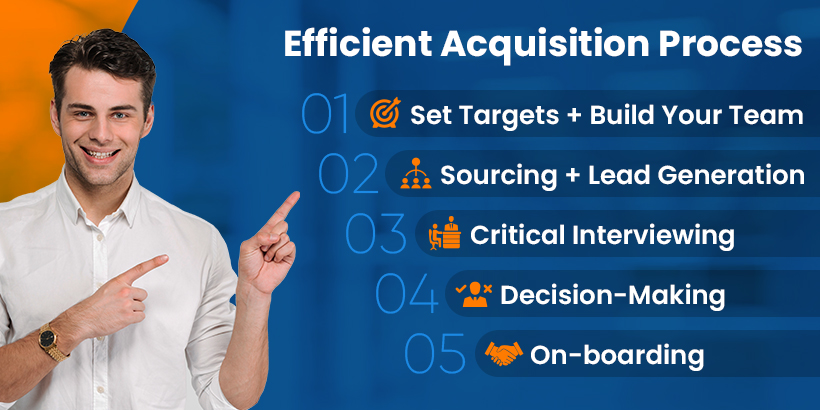
The success of any organization depends upon its smallest constituent unit: people. Highly determined and dedicated people can drive any business to its highest profit metrics.
Hence, it becomes very essential for stakeholders to make sure that they have a pool of perfect employees. The responsibility to fulfill this goal falls on the shoulders of the talent acquisition team: recruiters, HR professionals, recruiting managers, and lead generators.
Combined, these people work towards a simple common goal: finding the ideal candidates for various job roles.
Hence, talent acquisition involves all the processes like sourcing, attracting, interviewing,hiring, and onboarding suitable candidates.
Recruitment and Talent Acquisition - The Difference
Although both of the above share the same goal and seem synonymous, there’s a difference.
Recruiting is done to serve a simple, short-term process, i.e., fulfilling the current talent needs at any company.
Talent acquisition, on the other hand, includes crafting an extensive HR strategy that relies upon the business’s long-term goals. Under their talent acquisition strategy, a business recognizes the importance and value of onboarding the right people.
While recruiting aims at filling vacancies in the shortest time possible, talent acquisition is more strategic and serves long-term objectives. It includes a continuous hunt for the best - attracting and engaging talent with specific skills, experience, and perspectives.
Developing an Efficient Acquisition Process for Your Manufacturing
The process of talent acquisition is subjective and depends upon various factors such as business niche, long-term goals, current budget, workforce size, etc.
If you’re currently struggling at crafting a suitable talent acquisition strategy, here’s a simple approach you can follow:
Step 1: Set Targets + Build Your Team
First and foremost, your HR department needs to forecast & outline the long-term talent needs, in accordance with your business’s future goals.
Once your aims are clear, you should have an ample number of HR professionals (acquisition specialists, managers, coordinators, etc.) working towards attaining your acquisition goals.
Step 2: Sourcing + Lead Generation
The process of sourcing begins with crafting well-defined job descriptions. This is followed by a similar process to recruiting. The only difference is that talent acquisition requires you to be more patient with an eagle eye. Identify the social media channels, online forums, networking events, etc. that bring you close to the specialists you wish to acquire.
In contrast to reaching out to your ideal candidate, you should also begin to market yourself as their dream workplace. Cultivate a unique brand image, prioritize your employees’ well-being, and be a better employer than your competitors.
Click here to read our blog on new-age branding tips for manufacturing firms.
Step 3: Critical Interviewing
Once you have got your hands on a list of potential candidates, spend some time deciding the right questions to ask them. Always remain mindful of the fact that this hiring choice is going to have a large impact on how well you achieve your pre-set goals.
Take your time, allow the candidate some stress-free space, and make them aware of your expectations as an employer.
Another effective tip that we often recommend to our clients is the following: While an interview room is the best place to assess how a candidate performs “under pressure”, you also need to engage with them in less formal settings.
This helps in knowing the candidate better and exploring their personality type, career aspirations, work experiences, and more.
Step 4: Decision-Making
As discussed earlier, acquiring talent based on long-term goals is more sensitive than recruiting.
A good decision at this stage can result in increased profits and growth opportunities. Hence, your decision-makers should pay necessary heed to details such as references, personality types, resilience level, career growth curve, etc for each candidate.
Having relevant past experience is not enough. Your final candidate should have authentic references to back up the fact that he is the right choice.
Introducing referral bonuses to your employees is an effective way of getting better qualified and trustworthy leads.
Step 5: On-boarding
Once you are ready to bring in your ideal employee, make sure that they go through a smooth onboarding process. This is essential to make a good first impression, ensure no backouts, and introduce your company culture in the best ways.
How M&M can help with your talent acquisition process?
As a staffing partner, we at M&M aim at helping our clients reach their acquisition goals in the most efficient and stress-free ways.
Once a client decides to join hands, we begin with crafting a customized hiring approach based on the acquisition goals as briefed by the founder(s) and HR heads.
For each step of the process, our team of experts focuses on shortlisting the best talent available. For example: while generating organizational-fit leads, we refer to our rich and extensive list of sources, which has been cultivated with an experience of 18+ years in the manufacturing market of Ontario, Canada.
To help you make a well-informed decision, we have laid out the benefits our past clients have enjoyed: Winning With M&M!
Wondering what business with M&M looks like? Click here for an insightful sneak-peek.